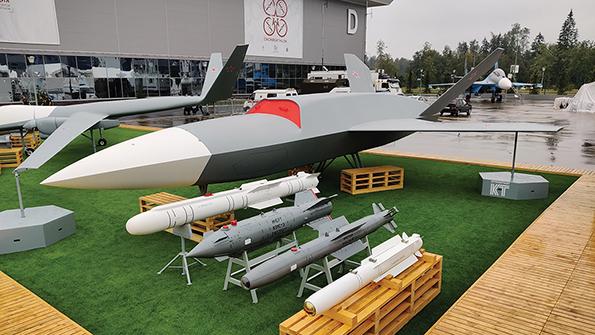Russia Reveals Loyal Wingman Concept

The Kronstadt Co. is building on the success of Russia’s first modern large unmanned aircraft system Inokhodets-BLA (Orion), revealing a full-scale mockup of its loyal wingman concept aircraft as well as its ambitions to expand in the large UAV market.
Russia’s foray into modern UAV development began long after that of the U.S. and other countries—and after the war with Georgia in 2008 revealed Russia’s military weaknesses. Moscow has since developed and started production of the Orion, the Russian equivalent of the General Atomics Aeronautical Systems MQ-1 Predator. Behind it, multiple projects are in the pipeline that could be exported to nations that do not want to buy aircraft from Europe, Israel or the U.S.
- Russia’s first large UAS, the Inokhodets-BLA (Orion), has entered service
- Trials of the Altius-RU and Okhotnik unmanned aircraft will continue for a few more years
- The Russian defense ministry is launching additional UAS programs
Kronstadt began with that Predator-replica Orion, mastering design and production of thin-walled ultralight structures made of carbon composites using a vacuum infusion method. Orion is also the first fully electric aircraft of this size in Russia. The company aims to use that experience to stay ahead of other Russian manufacturers and the needs of the nation’s defense ministry and to gain ground in the export market.
At the Army 2020 exhibition in Kubinka near Moscow in August, Kronstadt’s stand was dominated by a full-size mockup of the Grom strike aircraft. The Grom is intended as an unmanned “loyal wingman” that will fly in front of a group of manned aircraft to pave the way through an enemy’s air defense system using anti-radiation missiles.
According to the company, the manned fighter can guide three or four Grom unmanned aircraft systems (UAS). The Grom also can destroy surface targets and conduct reconnaissance and electronic jamming. It can carry weapons weighing up to 500 kg (1,100 lb.): two inside the fuselage and two suspended from underwing pylons, up to a total of 2 tons. The Grom is to be powered by two 2,500-kg-thrust (5,500-lb.) AI-222-25 turbofans, also used by the Yak-130 jet combat trainer.
For now, the Grom is being developed using internal funding, with the expectation of a Russian defense ministry contract. “Today, the [defense ministry] has an understanding that a UAV of this class should en masse come into service with the Aerospace Forces,” says Nikolai Dolzhenkov, designer general of Kronstadt.
The Orion is currently Kronstadt’s main product, developed under the defense ministry’s Inokhodets-BLA program. It is the first large UAS in Russia to enter production.
Kronstadt CEO Sergey Bogatikov said during Army 2020 that the first Inokhodets-BLA system had been delivered to the Russian Armed Forces and the company had been awarded a contract for further deliveries. The military also requested additional requirements, and a modernized version with weapons that were not included in the original requirements will be produced. “We are showing a modernized version with greater takeoff weight and weapons,” Bogatikov said.

Kronstadt is counting on traditional importers of Russian military equipment to buy the Orion, but the company faces stiff competition from China. The Chinese Casc CH-4 and Chengdu Wing Loong have been bought by Algeria, Egypt and Iraq as well as former Soviet Union states Kazakhstan and Uzbekistan. In civilian tasks, the Orion is being proposed to monitor large areas, such as for early detection of forest fires in Siberia or patrolling the Northern Sea route in the Russian Arctic. Russia’s legislature is developing a legal framework for the use of UAS in civilian airspace.
In addition to the Orion, Army 2020 featured a full-size mockup of the twin-engine Inokhodets-RU aircraft (Sirius), which is twice as heavy as the Orion. The name “Sirius” might cause a bit of confusion because at the MAKS 2019 exhibition that name appeared on a different aircraft, which is now being called the Helios. The new Sirius is important because the company received an order for it this year, said Bogatikov.
The aircraft has a takeoff weight of 2.5 tons, including 450 kg of weapons and stores, and can stay in the air 20 hr. at an altitude of 7,000 m (23,000 ft.). Bogatikov pointed out that Inokhodets-RU has a built-in satellite communication terminal, in contrast to the current Orion, whose radius is limited to the range of direct communication. “The system also includes a communication suite for cooperation with piloted aviation, which allows the use of our [UAS] in mixed formations,” he said.
A mockup of the aforementioned Helios UAS, also made by Kronstadt, was presented in the early-warning Helios-RLD radar picket variant with a large surveillance radar under the fuselage. The aircraft weighs 4,000 kg and can fly 30 hr. at 11,000 m altitude.

The Army 2020 exhibition also included displays closed to the public; footage of them was released by the defense ministry. That imagery showed two exhibits in a hangar at Kubinka Air Base on display for the defense minister and his entourage. Those included the new-generation Sukhoi Su-57 fighter and a large Sukhoi S-70 Okhotnik (Hunter) unmanned combat aircraft. The Okhotnik copy displayed in Kubinka carried the number “070”; it was probably a full-size mockup. The S-70B demonstrator, which has been undergoing flight tests since Aug. 3, 2019, bears the number “071.”
The S-70 Okhotnik is a flying-wing aircraft that weighs about 20 tons and is powered by a single 117BD turbojet engine, which is a nonafterburner version of the AL-41F1 (117) engine of the Su-57. It carries weapons in two internal bays, similar to the Su-57. The armament itself is also common to both the Su-57 and S-70.
The 7-ton Altius-RU high-altitude long-endurance UAS also was in the closed section of the exhibition. Two likely small air-launched UAVs, the Molniya (Lightning) and Pirania (Piranha), were among the closed exhibits, too.

Comments